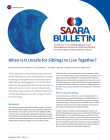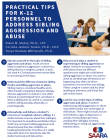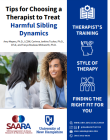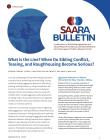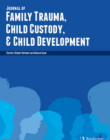Aggressive and abusive behaviors like kicking, punching, threatening, humiliating, or purposefully destroying cherished items sometimes happen between siblings. Unfortunately, these behaviors are often mislabeled and dismissed as harmless rivalry and a normal experience of growing up with a sibling. The research evidence is clear, however, that these behaviors can have harmful and potentially long-lasting impacts on mental, physical, and relationship health—and should not be ignored.
Certain family dynamics are associated with sibling aggression and abuse. Parents may unknowingly model negative behaviors that children then repeat. Parental conflicts, intimate partner violence, and child maltreatment are all associated with a sibling being harmed. Family adversity—such as job loss, illness and death—is also linked to sibling aggression and abuse.
What is Sibling Aggression?
Sibling aggression includes psychological, physical, and property aggression. It can be one-sided but is often mutual. Sometimes, mutual sibling aggression is minimized as "fair" or "just a fight," but mutual sibling aggression does not mean the exchange is harmless. Sibling aggression can be mild or severe.
- Mild aggression includes pushing, grabbing, insulting, and taking personal items. While mild aggression does not cause a physical injury, it may cause emotional and relationship harm, especially if it persists or escalates over time.
- Severe aggression leaves a physical or emotional injury and can involve the use of a weapon or weapon-like object. Examples of severe aggression include kicking, punching, beating, repeatedly calling a sibling dumb, ugly, unloved, or threatening significant harm. Such behaviors usually peak during adolescence.
Sibling aggression may happen for a number of reasons, including a lack of emotion regulation and problem-solving skills. At toddler and preschool ages, aggression between siblings can be developmentally appropriate as children are learning how to deal with frustration and anger. Still, it should not be ignored. Parents and professionals should stop aggressive behaviors immediately and consistently, increase supervision, and guide siblings on socio-emotional skills, like listening and conflict management. Learn More
Is it Sibling Abuse?
"My brother's abuse and how he terrorized me has impacted every day of my life negatively. I don't feel safe."
- Survivor of sibling abuse, from the SAARA Story Archive
Sibling abuse is one-sided and occurs in the context of a power differential between siblings based on age, gender, physical size, ability, social competence, family role, or parental favoritism. Sometimes, the sibling who causes harm has an underlying issue, like a compulsion, externalizing disorder, developmental disorder, or trauma experience.
Potentially abusive sibling behaviors include serious threats of harm, sexual contact, and physical violence. Abuse is often chronic, intense, and long-standing, but a severe one-time event may also fall under the definition of abuse. The harmed child may attempt to fight back or act in self-defense, but this should not be mistaken for mutuality.
Sibling sexual abuse shares much in common with physical and psychological abuse, and siblings can experience more than one type of sibling abuse. But there are also some unique features of sibling sexual abuse, including more frequent confusion about mutuality and sometimes greater secrecy and shame. Learn More
Sibling abuse leads to serious and enduring physical, emotional, and/or sexual harm and often results in estrangement. If a child tells a family member they are being harmed, they should be believed. Children rarely lie about abuse. Sibling abuse requires professional help to address safety concerns, family dynamics, parenting, and the mental health of all family members.









